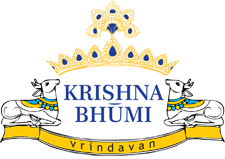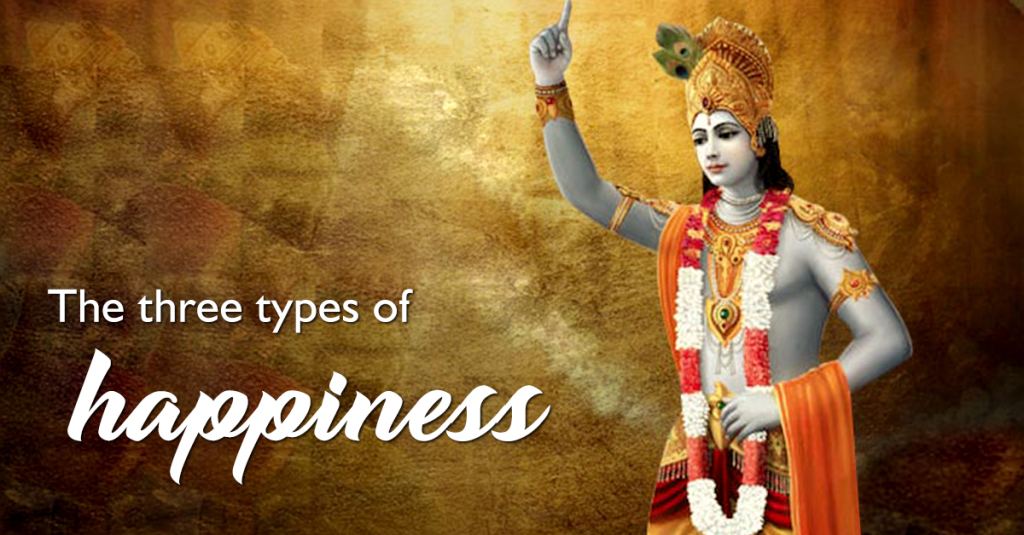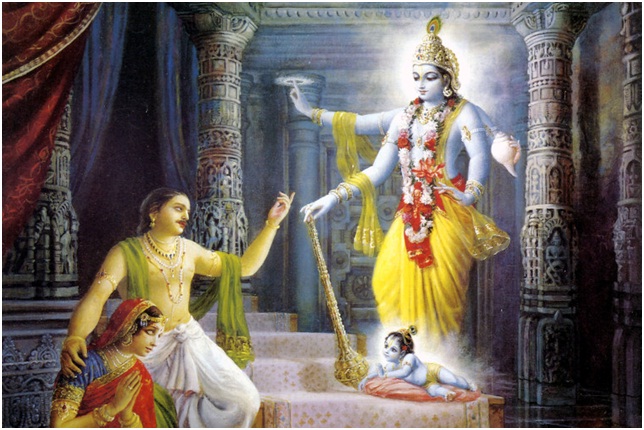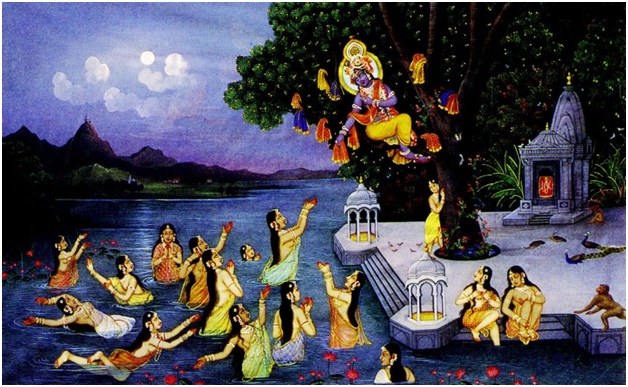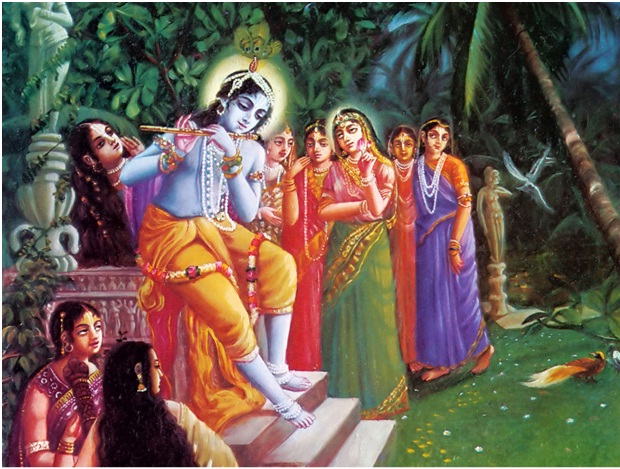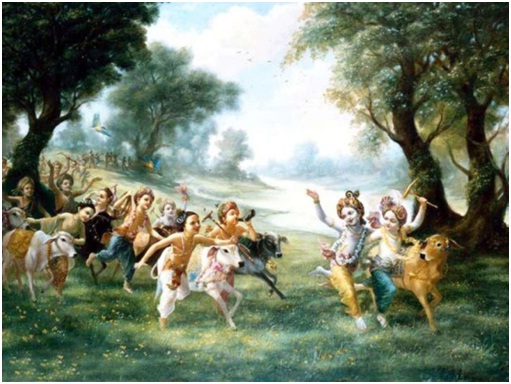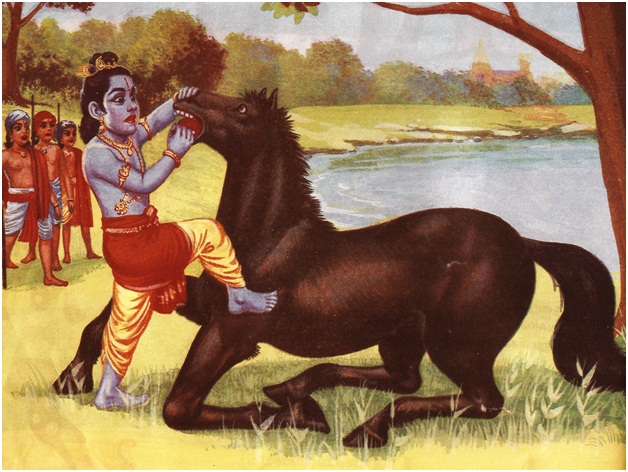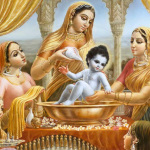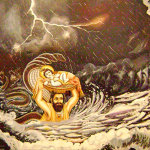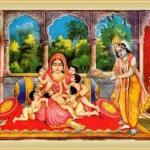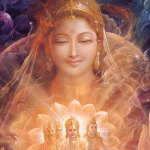What does Sri Krishna say about happiness in Bhagavad Gita?
What is the purpose of our life? What do we want to achieve? What is it that we crave for? It is happiness. We may be keen on performing certain actions and indulging in certain activities because those, we think, will make us happy. But, are we aware of the true meaning of happiness? Sri Krishna enlightens us about this elusive concept through his conversation with Arjun in Bhagavad Gita.
What is happiness?
We often associate happiness with a number of external factors. We often spend all our effort in the gratification of our senses. However, the happiness that is derived in this manner is only temporary happiness and becomes intertwined with cycles of sorrow. True happiness can only emanate from a peaceful mind that is not dependent on any external agents and remains unperturbed in every situation.
In Chapter II, Verse 70 of the Bhagavad Gita, Sri Krishna says,
“aapurya-manam achala-prathistham
samudram apah pravishanti yadvat
tadvat-kama yam pravishanti sarve
sa shantim-apnoti na kama-kaami”
Translation:
“As the waters (of different rivers) enters the Great Ocean, which though full on all sides remains undisturbed, like wise a person who is not disturbed by the incessant flow of desires – can alone achieve peace, and not the man who runs after these desires & strives to satisfy such desires.”
The three types of happiness
In Chapter 18, Verse 36 Sri Krishna says to Arjun,
“sukhaṁ tv idaniṁ tri-vidhaṁ shrinu me bharatarshabha
abhyasad ramate yatra duhkhantam cha nigachchhati”
Translation:
“And now hear from me, O Arjun, of the three kinds of happiness in which the embodied soul rejoices, and can even reach the end of all suffering.”
- Satvik or Pure happiness: It is the happiness that arises from the elevation of the soul. However, attaining this is not easy. One pursuing satvik or pure happiness has to practice a lot of discipline. That is why, it feels like poison in the beginning but nectar in the end.
“yat tad agre viham iva pariname mitopamam
tat sukham sattvikam proktam atma-buddhi-prasada-jam”
Translation:
“That which seems like poison at first, but tastes like nectar in the end, is said to be happiness in the mode of goodness. It is generated by the pure intellect that is situated in self-knowledge.”
Bhagavad Gita, Chapter 18, Verse 37
- Rajasik or result-oriented happiness: This is the materialistic pleasure that is derived when the senses come in contact with external objects that create a feeling of gratification. However, this kind of happiness is temporary.
“vishayendriya-sanyogad yat tad agre mritopamam
pariname visham iva tat sukham rajasam smritam”
Translation:
“Happiness is said to be in the mode of passion when it is derived from the contact of the senses with their objects. Such happiness is like nectar at first but poison at the end.”
Bhagavad Gita, Chapter 18, Verse 38
- Tamasic or slothful happiness: This is the lowest form of happiness and is derived from sleeping or being lazy. The soul is never nurtured through these practices yet since there is a tiny sense of pleasure associated with it, people wrongfully consider it to be a state of happiness.
“yad agre chanubandhe cha sukham mohanam atmanah
nidralasya-pramadottha tat tamasam udahritam”
Translation:
“That happiness which covers the nature of the self from beginning to end, and which is derived from sleep, indolence, and negligence, is said to be in the mode of ignorance.”
Bhagavad Gita, Chapter 18, Verse 39.
One can derive true happiness only by achieving a peaceful state of mind. Why not come to Vrindavan and immerse yourself in the thoughts of Sri Krishna? There is no greater happiness than the happiness one gets from being at peace with oneself and being one with god.
Radhe Radhe!
Who is Devi Katyayani and how is she related to Sri Krishna?
Chaitra Navratri has already begun this year. It is the time when devotees offer prayer to the nine forms of Durga, one of which is Katyayani Devi or Yogamaya Devi, a form of Durga worshipped on the sixth day of Navaratri.
But who is Yogamaya Devi or, as she is also known, Katyayani Devi? What is her significance in the holy Braj and how is she related to Sri Krishna?
Who is Devi Katyayani?
It is believed that Yogamaya Devi is Lord Vishnu’s divine power that makes all creation possible. According to the Bhagavatam, it was Yogamaya who made all the guards of Kansa’s prison fall asleep when Sri Krishna was born to Devaki.
In Lord Vishnu’s scheme of things during His birth as Sri Krishna, Yogamaya played an important part. At first, she transferred the foetus of Devaki’s seventh unborn child to Rohini’s womb so that Adisesha could be born as Balaram, took birth as Yashoda and Nanda’s daughter, and made the swapping of Krishna and Yogamaya at birth possible.
Later, when Kansa tried to kill the little girl he found on Devaki’s bed, she slipped out of his hands and predicted Kansa’s death by someone growing up elsewhere. Yogamaya Devi took various forms, one of which is Katyayani.
Yogamaya as Devi Katyayani in Chir Ghat
It is believed that Sati’s hair fell on Vrindavan which makes it one of the 51 shaktipeethas. However, it was not until Swami Keshavananda came to Vrindavan about a hundred years ago that the actual temple that was built at the spot where Sati’s hair fell could be identified. According to the swami, it was the Katyayani temple at Chir Ghat near Rangji’s Bade Bagicha that stands at the holy place.
Katyayani Vrat and Sri Krishna
Legend has it that the gopis observed the Katyani Vrat and prayed to the goddess with the desire of getting Sri Krishna as their husband. A beautiful deity of the goddess stands at Chir Ghat even today.
One day, when the gopis, as part of their Vrat were taking a bath in the Yamuna, Sri Krishna mischievously stole all their clothes and took those to a nearby kadamba tree. However, it would be wrong to equate Sri Krishna’s act as a mundane affair. This holy episode of the Lord’s life signifies the importance of renouncing all materialistic attachments (symbolised by the clothes) for a devotee to completely surrender herself/ himself to the Supreme Godhead.
Sri Krishna and Yogamaya
Yogamaya was born to Yashoda on the same day Sri Krishna was born to Devaki, and then they were swapped. This makes Yogamaya Krishna’s foster sister. However, that’s not the only relationship they have.
Srila Prabhupada in the 4th chapter of the Sri Caitanya-caritamrta Adi-lila says, “…Yogamāyā is the name of the internal potency that makes the Lord forget Himself and become an object of love for His pure devotee in different transcendental mellows. This yogamāyā potency creates a spiritual sentiment in the minds of the damsels of Vraja by which they think of Lord Kṛṣṇa as their paramour.”
Vrindavan is that holy place on earth where Sri Krishna spent his youth and performed many leelas. There is magic in its air, a magic that can only be experienced by coming here and surrendering yourself to Sri Krishna. Krishna Bhumi can make it happen
Radhe Radhe!
Five mythical places that actually exist in Vrindavan
The Adi Purana says, “In all the three planetary systems, this earth is especially fortunate for here stands the town of Vrindavana”. But why is it so? What is so special about Vrindavan? Srila Prabhupada offers an answer in the introduction to Srimad Bhagavatam, “Vrindavana dhäma is non-different from Krishna because the name, form, fame, and place where the Lord manifests – are all identical with the Lord as absolute knowledge. Therefore, Vrindavana dhäma is as worshipable as the Lord.”
There is magic in Vrindavan, a magic that has survived thousands of years and has made its way into the modern times. But to experience it, one must come to this blessed land, the land that had once witnessed Sri Krishna’s leelas, felt the touch of His feet, and watched Him kill many demons.
Isn’t it amazing that in Vrindavan, you can actually visit all those places that you have only read about in various mythological texts?
Here are five such mythical places in and around Vrindavan Dham that you should visit:
Bhandirvan: One of the Dwadasha Kanana (12 forests)
Legend has it that there were 12 forests in Braj in the Dwapara Yuga. Bhandirvan is one of the celebrated forests among all 12 because many important events in Sri Krishna’s life took place here. It was here that Krishna and Balaram killed the demons Vatsasura and Pralambhasura. It is also believed that Sri Krishna gathered with His friends under the Bhandirvata and had lunch every day.
The Bhandirvan also has the deities of Shri Shri Radha Bhandirbihari where Sri Krishna is seen putting sindoor (vermillion) on Radharani’s forehead. Legend has it that Sri Krishna married Radharani under the Bhandirvata. Lalitha and the other sakhis made all the arrangements and Brahma acted as the head priest.
Shringar Vat: The place where Sri Krishna adorned Radharani
During Raas Leelas, Sri Krishna danced with every gopi, but He also needed to be alone with Sri Radha for the leela to reach its supreme state. So, Radharani left the place and Sri Krishna followed her. Once alone, He adorned His beloved Radha with flowers and combed her hair at the Sringar Vat.
Years later, when Nityananda Prabhu visited Vrindavan, he chose the Sringar Vat as the place to meditate. Once there was a huge banyan tree at the spot, but now only its stump remains.
Raman Reti: The playground of Sri Krishna
A few kilometres away from Mathura stands Raman Reti, quietly narrating a story of the bygone days. It was here that Sri Krishna played with Balaram and other friends. The sands (reti) of this place stand testimony to the divine plays (raman) of Sri Krishna. It is also believed that Sri Krishna met Radharani at Raman Reti before visiting Vrindavan together.
Many saints chose Raman Reti to meditate and to perform austerities in order to please Sri Krishna. Today, there is a deer sanctuary, small temples, and the Karshni Ashram beside Raman Reti.
Kesi Ghat: Where Sri Krishna took a bath after killing demon Kesi
There is hardly a place in Vrindavan that is not touched by Sri Krishna’s miracles. The Kesi Ghat is no exception. It is believed that Kansa sent Kesi to kill Krishna. Kesi took the form of a fearful horse and started killing innocent Brajwasis. Krishna understood that it was He who could stop the demon. He forced His fist inside the horse’s mouth and killed it because Sri Krishna’s fist felt like a hot iron rod. After killing Kesi, Sri Krishna took a dip in the holy Yamuna at the Kesi Ghat.
Kadamba tree in Chir Ghat: Where Sri Krishna playfully stole the gopis’ clothes
It is believed that the gopis wanted Sri Krishna as their husband and prayed to Mother Katyayani to fulfil their desire. One day, when they were taking a bath in the Yamuna, Sri Krishna stole their clothes and brought it to the holy Kadamba tree that is still there at Chir Ghat.
Radhanath Swami explains the higher significance of Sri Krishna stealing the clothes of the gopis. He says that the act signifies the devotees’ complete surrender to the Supreme Being which necessitates the freedom from all attachments and mundane possessions symbolised by the clothes.
There are many such places in Vrindavana and the Braj that tells the tale of Krishna’s magic. Come, spend a blissful week in Vrindavan. Krishna Bhumi Holydays can make it happen. Radhe Radhe!
THE THREE MOST IMPORTANT WOMEN IN SRI KRISHNA’S LIFE
There was hardly any woman, young or old, who was not influenced by Sri Krishna’s disarming charm. Legend has it that Sri Krishna had 16,008 wives. However, how was His relationship with the three most important women in His life— Yashoda, His mother, Rukmini, His first wife, and Radha, His unrequited love? Were all of them Krishna devotees?

Krishna and Yashoda
Although Krishna was born to Devaki, it was Yashoda who had the good fortune of bringing Him up. She was the one who experienced the joys of holding Bal Gopal when He took His first steps, of feeding Him, of putting Him to sleep, and of watching Him grow up to a lovely youth.
According to a story, one day, when Narada arrived at Mathura, he saw mother Yashoda bathing her Krishna. Her legs were stretched and Krishna was lying on her legs with His face down. He clutched onto Yashoda’s toes in order to avoid falling off. Narada was overwhelmed by what he saw and wondered what penance had Yashoda undertaken in her previous life so that the Lord Himself was touching her feet.
Later, when it was time for Bal Krishna to walk, mother Yashoda held His lotus fingers and helped Him take His first steps. Vishnu in His Trivikrama avatar measured the three worlds with His three giant steps and here was Krishna ‘allowing’ a mere mortal to hold His hands and teach Him walking. Again, it was Yashoda who saw the seven oceans, the whole universe, and Narayana seated upon Adishesha beside Mahalakshmi inside little Krishna’s mouth.
Yashoda’s affection for Krishna was more than ‘Vatsalya Prema’. Her love for Krishna was more than motherly love; it was ‘Vatsalya Bhakti’, mother’s devotion.

Krishna and Radha
Radha Rani was not just one of Sri Krishna’s gopis; she was the most important one. Many consider Radha as the ‘Devotional Energy’ of Sri Krishna. In fact, she was an integral part of Krishna. That is one of the reasons why we take her name before Krishna’s name. It is her divine love that completes the entity of Sri Krishna. If we remove the ‘R’ from Radha-Krishna, we are left with ‘adha’ or ‘half’ Krishna.
There are many stories that narrate the eternal love between Radha and Krishna. One such is a story of the night when Krishna told Rukmini that He was not feeling well because He did not drink warm milk that Radha used to give Him before He retired to bed every night. Hearing this, Rukmini went to Radha’s house to fetch some milk. But when Radha heard about it, she drank the milk herself. Rukmini was perplexed but she came back to Krishna. Upon returning, she found that there were boils on Krishna’s feet. These were not there when she left. Krishna explained that Radha drank very hot milk which gave Him the boils.
Radha was devoted to Krishna all her life, even after He left Mathura and even though they never married. Srila Prabhupada, while talking about the love between Radha and Krishna says, “…in the spiritual world, the highest, topmost level of love is parakiya. Parakiya means love – not by marriage, but by friendship. There, it is pure”.

Krishna and Rukmini
Princess Rukmini was deeply in love with Krishna even before they met. She made up her mind to marry Krishna but her brother Rukmi was dead against it. Rukmini wrote a secret letter to Krishna where she suggested that they should have a ‘rakshasa vivaha’ where the bride is abducted. Krishna conceded.
Once in Dwarka, they had a grand wedding. Krishna loved and respected Rukmini. He also gave her the name ‘Sri’ and said that from then on He will be known as Sri Krishna, taking Rukmini’s name before Krishna’s name. It is believed that Rukmini was an incarnation of Goddess Lakshmi who followed Vishnu whenever He came to the earth in the human form.
The tulabharam story talks about the depth of Rukmini’s love for Krishna. Legend has it that Narada once told Krishna’s second wife, Satyabhama, that He loved Rukmini more than her. Narada said that if Satyabhama accepted the tulabharam challenge and won it, Krishna would love her more. Instigated by Narada’s words, Satyabhama accepted the challenge in which Krishna sat on one side of a weighing scale (tula) and Satyabhama put all her wealth on the other scale but failed to match it to Krishna’s weight. Confused by what she saw, Satyabhama asked Rukmini to help. Rukmini simply put a tulsi leaf on the pile of wealth and immediately outweighed Krishna. This shows that Sri Krishna does not want wealth from a devotee. All He wants is devotion and Rukmini indeed was an ardent Krishna devotee.
Radhe Radhe!
